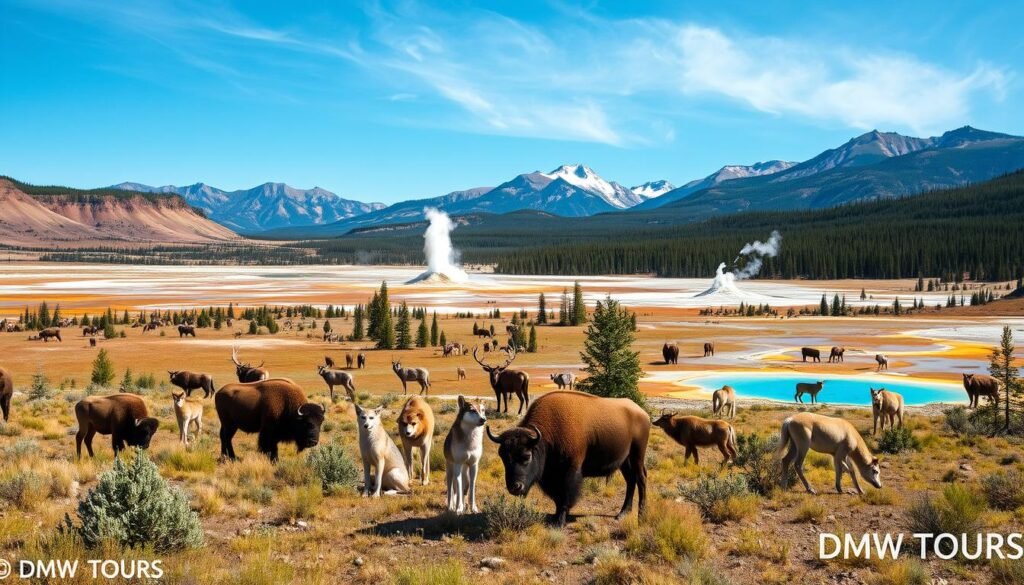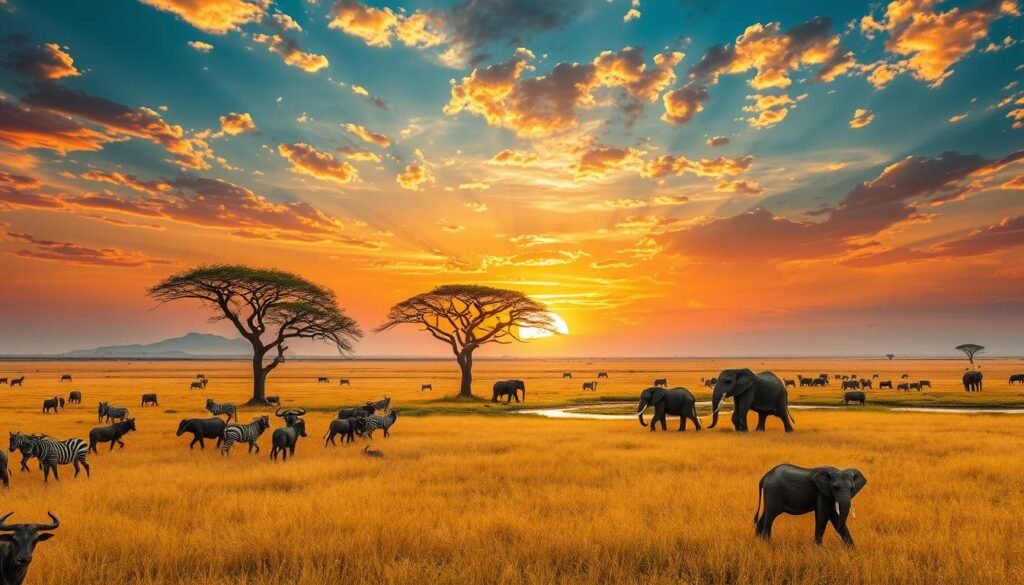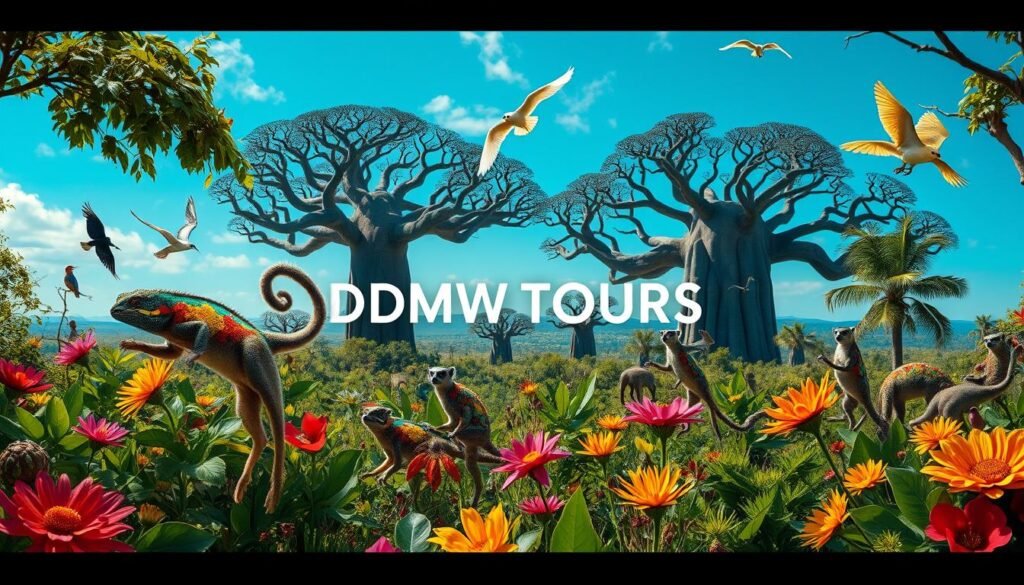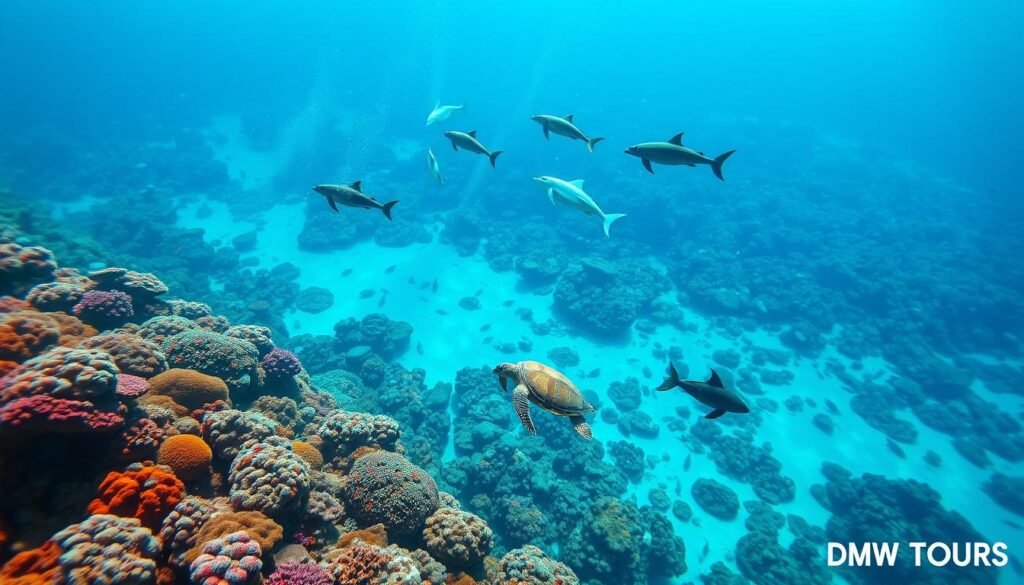John Muir once said, “In every walk with nature, one receives far more than he seeks.” This is especially true for wildlife lovers. They go on adventures, seeking amazing moments in nature. The world is full of incredible places to see wildlife, from Africa’s vast lands to South America’s dense jungles.
Seeing animals in their natural homes is truly amazing. Places like the Galapagos Islands and Kruger National Park are famous for their wildlife. Yellowstone National Park and the Amazon Rainforest are also great spots for wildlife watching.
Imagine watching a humpback whale in Iceland or seeing the Serengeti’s migration in Tanzania. These experiences are waiting for you. They are just a trip away.
For more information, check out the best wildlife travel destinations. These places are filled with amazing animals and a focus on saving the environment.
Key Takeaways
- Explore diverse ecosystems in premier conservation areas.
- Experience unique wildlife behaviors in their natural habitat.
- Witness breathtaking spectacles such as migrations and breeding seasons.
- Embrace ethical tourism and conservation efforts in your travels.
- Discover how different geographical regions shape wildlife populations.
Introduction to Incredible Wildlife Travels
Traveling to the best wildlife destinations is a unique chance to dive into nature’s wonders. You get to see amazing wildlife in their homes and learn about our ecosystems. These trips not only give you memories but also teach you about caring for our planet.
Wildlife lovers can visit top wildlife spots worldwide. Places like Costa Rica and Madagascar are full of unique animals. The Galapagos Islands let you see rare creatures like giant tortoises and marine iguanas. Kruger National Park in South Africa is famous for its Big Five animals, perfect for safari fans.
These trips show you endangered animals like orangutans and Bengal tigers. They also teach us about saving these animals. In places like Madagascar’s rainforests, you see lemurs and chameleons, showing how we can help protect them. With the right approach, your trip can help keep these amazing creatures safe for the future.
Every wildlife trip is full of new sights and experiences. You might see the Great Migration in East Africa or take wildlife photos in the cold. These moments help you feel closer to nature. By traveling wisely, you help both animals and local people.
Get ready for exciting wildlife adventures around the world. Each trip is a chance to learn and help protect wildlife. Enjoy nature’s beauty while making a difference123.
Serengeti National Park, Tanzania
Serengeti National Park is a top nature reserve known for its amazing wildlife. It attracts visitors from all over the world. Here, you can see the Great Migration, a natural wonder that draws over 1 million animals.
This event shows the animals’ struggle to survive as they cross the Grumeti River. It’s a sight to behold, filled with danger and beauty45.
The Great Migration Experience
The Great Migration is a highlight of visiting the Serengeti. It’s a thrilling experience where animals move in large numbers. You can watch them try to cross rivers while avoiding predators.
It’s a chance to capture stunning photos and learn about the animals’ survival. The migration also supports a rich ecosystem, home to many animals45.
Diverse Wildlife Viewing Opportunities
In the Serengeti, you can see a wide variety of wildlife all year. The park covers 15,000 square kilometers. Here, you might see lions, leopards, cheetahs, elephants, giraffes, and many birds.
Places like Moru Kopjes and Retina Hippo Pool are great for observing unique animal behaviors. They make your safari adventure even more special as you explore the park’s lively ecosystems45.

Galapagos Islands, Ecuador
The Galapagos Islands are a paradise for nature enthusiasts. They offer breathtaking views and a chance to see unique species. These islands are a top spot for wildlife adventures, where you can see animals like giant tortoises and blue-footed boobies up close.
These animals are not afraid of people. It’s a rare chance to interact with wildlife in such a way.
Unique Species Encounter
The islands are home to over 5,000 species, with 1,900 found nowhere else. About one-third of the plants and nearly half of the birds have evolved to live here. Marine iguanas are common, with the biggest population on Fernandina’s Punta Espinosa6.
This diversity makes the Galapagos a top place for wildlife watching.
Conservation and Ethical Tourism
Responsible tourism is key to protecting these delicate ecosystems. The Charles Darwin Research Station on Santa Cruz Island helps giant tortoises. Isabela Island’s Centro de Crianza and La Galapaguera on San Cristóbal are also important for tortoise conservation6.
By choosing ethical tourism, you help save these unique species and their homes.
Yellowstone National Park, USA
Yellowstone National Park is a top spot for wildlife watching in the United States. It covers over 3,471 square miles of different habitats. Here, you can see many animals, including grizzly bears, wolves, and bison.
Every year, millions of people visit to see the amazing wildlife. There are many great places to watch wildlife in the park.
Wildlife Diversity in North America
Yellowstone is home to over 300 bird species and many mammals. You can see elk, pronghorn, and black bears here7. Lamar Valley is the best place for wildlife watching, with bison, elk, bears, and wolves7.
Early mornings in Lamar Valley are the best time to see wildlife. It’s a great place for your wildlife adventures8.
Geothermal Features and Wildlife
Yellowstone is also known for its geothermal features like Old Faithful. You can see bison and elk nearby. Some areas around these features are good for wildlife watching8.
Remember to stay at least 100 meters away from bears and wolves. Keep 25 meters away from other animals8. It’s important to protect these habitats for the park’s ecosystem.

| Location | Animals to See | Recommended Viewing Times |
|---|---|---|
| Hayden Valley | Bison, elk, black bears, coyotes | Morning, Evening |
| Lamar Valley | Bison, elk, moose, bears, wolves | Morning, Evening |
| Fishing Bridge | Grizzly bears | Afternoon |
| Old Faithful | Bison, elk | All Day |
| Mammoth Hot Springs | Bison, black bears | Morning, Evening |
Yellowstone is a place of wonder, with its wildlife and geothermal features. It’s a great place for those who love nature9. This park is a sanctuary for its animals and a top wildlife destination.
Kruger National Park, South Africa
Kruger National Park is a top wildlife hotspot in the world. It’s a place where you can see the legendary Big Five: lion, leopard, elephant, buffalo, and rhino. You’ll also see other animals like impala, zebra, and giraffes.
The park covers two million hectares. It has different ecosystems, from dense bush to lush riverine areas. This makes it perfect for over 200,000 mammals and hundreds of bird species1011.
Home of the Big Five
The best time to visit is from May to September. During this time, the animals gather around waterholes, making it easier to see them1011. July and August are busy months, so book early to find a place to stay10.
The southern region is great for game viewing. It has luxurious lodges, perfect for your wildlife travel bucket list.
Biodiverse Ecosystems
Try the Skukuza to Satara drive, which is 93km long. It gives you plenty of time to see wildlife along the way12. Each drive offers something new, from beautiful landscapes to amazing wildlife sightings.
You can choose guided drives or drive yourself. This way, you can make your wildlife adventure your own10. Spend at least three to four days here to fully enjoy Kruger’s biodiversity and make unforgettable memories11.
| Route | Distance (km) | Recommended Time |
|---|---|---|
| Skukuza to Satara | 93 | 5 hours |
| Skukuza to Lower Sabie | 46 | 2-3 hours |
| Malelane to Skukuza | 64 | 3.5 hours |
| Olifants Loop | 81 | 4 hours |
Borneo, Malaysia & Indonesia
Borneo is a top wildlife spot, known for its rich biodiversity and unique habitats. It’s shared by Malaysia, Indonesia, and Brunei. The island’s lush rainforests are home to many species, making it a favorite among wildlife lovers and adventurers.
Here, you can see endangered animals like the orangutan. They face big threats from palm oil plantations1314.
Orangutan Sightings
Exploring Borneo’s rainforests offers amazing chances to see orangutans and other wildlife. The Sepilok Orangutan Rehabilitation Centre is a key spot for conservation. It lets visitors get close to these incredible animals.
Places like Gunung Mulu National Park offer stunning views and chances to see endangered animals. You can see proboscis monkeys and Sunda clouded leopards here1315.
Borneo is also home to many other species, like the marbled cat and western tarsier. These are both on the IUCN Red List14. The Kinabatangan River is famous for its wildlife, including pygmy elephants and saltwater crocodiles. It’s a paradise for wildlife photographers and enthusiasts1415.
Visiting places like Danum Valley Conservation Area and Bako National Park lets you dive into Borneo’s biodiversity. Each place has its own ecosystem, showing off the island’s unique plants and animals. With over 15,000 species, Borneo’s rainforests are some of the last untouched areas in the world15.

Costa Rica: A Wildlife Paradise
Costa Rica is a leader in ecotourism, with a wide range of biodiversity and habitats. You can explore exotic wildlife destinations across the country. Here, over 500,000 species, nearly 5% of the world’s, live in different ecosystems. From dense rainforests to cloud forests, there are many places to see wildlife.
Ecotourism Benefits
Costa Rica is known for its ecotourism, supporting travel that helps the environment and local people. Places like Manuel Antonio National Park are key for animals and conservation16. The rainy season, from July to December, is great for seeing sea turtles nest on beaches17.
Variety of Wildlife Habitats
Costa Rica’s varied landscapes support many ecosystems and wildlife. For example, the Monteverde Cloud Forest Reserve is famous for its biodiversity, with animals like sloths and quetzals18. The Osa Peninsula is the only place to see all four monkey species, making it a must-visit17. The country is also known for its birdlife, with over 800 species, including six types of toucans.
Amazon Rainforest, Brazil
The Amazon Rainforest is a top wildlife destination, home to many species and habitats. It covers about 6.7 million km² (2.6 million sq mi), making up 40% of South America19. This vast area is home to 10% of all known species, making it a paradise for wildlife lovers2019.
Immense Biodiversity
In the Amazon, you’ll see many wildlife species. The Amazon Basin has over 10% of the world’s lifeforms20. Look out for monkeys, caimans, sloths, and colorful birds during your visit.
Manu National Park in Peru is famous for its biodiversity, with over 1,000 bird species21. Jau National Park also protects a large part of this ecosystem, with 120 mammal species and 455 birds20.
Ecological Significance
The Amazon is crucial for our planet. It helps regulate the climate and supports indigenous cultures21. Visiting places like Yasuni National Park in Ecuador can raise awareness about conservation2119.

| Location | Area (Acres) | Notable Wildlife |
|---|---|---|
| Jau National Park | 5.6 million | 120 mammal species, 455 birds |
| Manu National Park | 1.5 million | 1,000+ bird species |
| Pacaya-Samiria National Reserve | 7.9 million | Jaguars, tapirs, monkeys |
| Yasuni National Park | 1.2 million | 600 bird species, 400 fish species |
Exploring the Amazon is an adventure. You’ll see its beauty and help protect a vital ecosystem. Remember to plan for the seasons and take health precautions20.
Ranthambore National Park, India
Ranthambore National Park is a top spot for seeing the Bengal tiger in the wild. It covers 1,334 square kilometers and was a royal hunting ground. Today, it’s a key wildlife destination in India, known for its biodiversity and stunning landscapes22. It’s a must-see for wildlife lovers.
Spotting the Elusive Bengal Tiger
Seeing the Bengal tiger in Ranthambore is a major draw. India is home to 70% of the world’s tigers, making it a leader in tiger conservation23. Safaris here offer great chances to see these animals, often near water or hunting in the bushes.
Cultural Heritage Sites
Ranthambore is not just about wildlife; it’s also rich in history and culture. Ancient forts, temples, and palaces dot the park, blending nature and heritage. The Ranthambore Fort, a UNESCO World Heritage Site, is a highlight. It offers a unique mix of history and wildlife, making Ranthambore a key stop for any wildlife trip.
Masai Mara National Reserve, Kenya
The Masai Mara National Reserve is a top spot for wildlife watching. It’s famous for the Great Migration. This area covers about 370,000 acres and welcomes 1.5 million wildebeests from July to October2425. The lush landscapes attract both herbivores and predators, making it exciting for photographers and nature lovers.
Wildebeest Migration Highlights
Nearly two million wildebeests migrate through the Mara-Serengeti ecosystem from July to November. This is one of the most amazing wildlife sights2425. During this time, they cross rivers where they face crocodiles, creating a memorable sight.
Game drives in the Masai Mara, offered twice a day, let visitors see these events up close. They also have a chance to spot the ‘Big Five’26.

Accommodations in the area range from luxury to budget-friendly. For example, Cottar’s 1920s Safari Camp offers luxury at $1,059 per person per night. Sand River Camp is more affordable, costing about $670 per person24.
New options are also available. These include renovated camps with big tents, private verandas, and swimming pools. They attract more visitors each year26.
Ultimate Wildlife Destinations Must Watch
For those who love nature, there are many amazing places around the world. These spots offer incredible wildlife experiences and unique interactions. They show the beauty of our planet’s biodiversity. It’s important to engage with local ecosystems, supporting conservation and sustainable tourism.
Top Recommendations for Nature Lovers
Here are some top wildlife watching locations for your next adventure:
- Zakouma National Park, Chad: Famous for its huge elephant herds, sometimes up to 550 at once. It’s a top spot for safari fans27.
- Okavango Delta, Botswana: A peaceful wilderness with many animals like wild dogs and lions. It’s one of Africa’s most diverse wildlife spots27.
- Serengeti National Park, Tanzania: Over 14,000 square kilometers with more than 2 million animals. It’s great for seeing the Great Migration28.
- Osa Peninsula, Costa Rica: The most biologically intense place on Earth. You can see amazing wildlife like tree frogs and sea turtles27.
- Pousada Trijuncao, Brazil: See rare maned wolves and black jaguars. Expert guides make your wildlife experience even better27.
Must-Visit Wildlife Sanctuaries and Reserves
There are also many other wildlife attractions worth visiting:
- Donsol, Philippines: Swim with whale sharks in their natural home. It’s eco-friendly tourism that respects these creatures28.
- Gorilla Trekking in Uganda: Meet about 400 gorillas in Bwindi’s forest. It’s a unique adventure28.
- The Maldives: Dive into the marine life, including coral reefs and manta rays. It’s perfect for snorkeling and diving27.
- Mirissa, Sri Lanka: See the Blue Whale, the largest mammal, on guided tours from November to April28.
- Wild Camping in the French Pyrenees: Find rare mountain butterflies and golden eagles. It’s a nature experience with little environmental impact27.
Discover the Richness of Madagascar
Madagascar is a top wildlife travel spot, known for its unique plants and animals. It’s the fourth largest island in the world. Here, you can see many species of lemurs that exist nowhere else29. The Avenue of the Baobabs, with trees over 800 years old, is a sight to behold for nature enthusiasts29.
Unique Flora and Fauna
Tsingy de Bemaraha National Park is a must-see for wildlife lovers. It’s a UNESCO World Heritage Site with stunning limestone formations29. Ranomafana National Park is famous for its hot springs and diverse wildlife. The best time to visit is from April to December, when the flora and fauna are in full bloom2930.
Madagascar’s ecosystems are perfect for observing wildlife in its natural home.
Wildlife Rehabilitation Efforts
Madagascar is working hard to protect its wildlife. They focus on rehabilitating injured animals and releasing them back into the wild. Whale watching in Île Sainte-Marie is a favorite activity from July to September. It shows the beauty of marine life and the importance of protecting it2930.

Spitsbergen: An Arctic Adventure
Spitsbergen is a top choice for those who love Arctic wildlife. It offers stunning landscapes and the chance to see incredible animals in their home. It’s perfect for those looking for the best wildlife travel experiences, especially for seeing polar bears, seals, and arctic foxes.
Polar Bears and Arctic Wildlife
On your trip, you can go on an 11-day expedition to Spitsbergen’s western edge. You’ll see amazing fjords and islands full of wildlife. Prices start at $8,937.00, and you’ll get a $200 credit per person from Polar Dream Travel31.
This adventure includes snowshoeing and sea-kayaking. It’s a great way to see this incredible place31.
You’ll have many chances to see wildlife, like polar bears, whales, and walruses. Spitsbergen is a must-see for wildlife lovers31. The colorful tundra and wildflowers are breathtaking, and you’ll find amazing photo spots like the 14th of July Glacier and Smeerenburg31.
Traveling on the Ultramarine gives you access to many public areas. You can choose from Explorer Triple and Explorer Suite cabins, perfect for up to three or two guests32. This cruise is designed to give you the best experience in these beautiful, harsh landscapes32.
Great Barrier Reef, Australia
The Great Barrier Reef is a top wildlife adventure spot, known for its amazing marine life. It stretches over 600 islands and has more than 3,000 reefs. This UNESCO World Heritage site is perfect for wildlife watching, with many activities to explore its vibrant ecosystem.

Diverse Marine Life Exploration
At the Reef, you can see many marine creatures like clownfish, turtles, and reef sharks. During migration, humpback whales are also seen. This makes it a top spot for wildlife watching, with each dive or snorkel revealing stunning underwater scenes.
Activities like 4WD Tours, Dinner Cruises, and Scenic Flights let you see the Reef from different angles. Cairns and Port Douglas are great places to start your adventure. Cairns is especially known for its excellent scuba diving and snorkeling tours33.
Snorkeling and Diving Opportunities
The Great Barrier Reef is great for all levels of divers and snorkelers. You can try snorkeling, scuba diving, kayaking, and stand-up paddleboarding. Islands like Green Island and Fitzroy Island offer special snorkeling spots, with Green Island having a rainforest.
Joining conservation efforts helps protect this amazing place for the future. This makes the Reef not just a beautiful place to visit but also a meaningful one.
For more details and to plan your trip, check out the top attractions on the Great Barrier. There, you can find booking information to help plan your adventure.
| Activity | Description | Notable Locations |
|---|---|---|
| Snorkeling | Explore the vibrant coral reefs at your own pace. | Green Island, Fitzroy Island |
| Scuba Diving | Dive into the depths of the coral gardens. | Cod Hole, Ribbon Reefs |
| Whale Watching | Witness the majestic humpback whales during migration. | Fraser Coast, Port Douglas |
| 4WD Tours | Adventure across rugged terrains leading to scenic views. | Whitsundays |
| Dinner Cruises | Enjoy a romantic meal while taking in the stunning ocean views. | Cairns |
Conclusion
Visiting top wildlife destinations lets you connect with nature and learn about wildlife’s role in our ecosystem. Adding these unforgettable places to your travel list helps global wildlife conservation. Each spot, from Costa Rica’s landscapes to the Galapagos Islands’ unique species, shows why we must protect these habitats for the future.
Planning a trip to the Serengeti for the Great Migration or the Amazon rainforest is exciting. These experiences create lasting memories. They let you see amazing creatures in their homes and teach us to care for our planet’s wildlife.
Begin planning your wildlife adventure by looking into the best spots for wildlife lovers. The journey is waiting, and your travel choices can make a difference. For inspiration, check out resources for unforgettable wildlife experiences and travel ideas to spark your next adventure34.

Leave a Reply